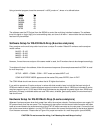
2
TELEDYNE API RS232 MULTI-DROP ADAPTOR
The Teledyne API RS232 Multi-drop Adaptors #01427 (A-series) and #04528 (E-series) provides the user with a
simple method of communicating via asynchronous RS232 with multiple Teledyne API instruments using a single
host system (computer, modem, DAS or terminal).
Overview of Adaptor Features
1. Dual DB 9 pin connectors - connected in parallel for ease in interconnecting with additional adaptors in
network. Will not interrupt communication with other instruments on the network should an instrument be
off-line, lose power, or fail. Network connectors may be connected in any order.
2. Standard connectors are DB-9S 9 pin female. Optional dual DB-9P male (#01428-01) or one each male
& female (#01428-02) cable assembly can be replaced in the field at any time.
3. Configuration switch DTE/DCE
- changes the signal lines at the adaptor to the analyzer as dictated by
the host system without the necessity of special wiring cables or “Null MODEM” connectors in most
installations.
4. Impedance switch TERM/HI-Z
- inserts a 5KΩ termination when set to the “TERM” position. When set to
the “HI-Z” position, impedance is approximately 300KΩ. Only one adaptor in the network should be set to
the “TERM” position.
NOTE: If multi-drop network includes non-Teledyne API equipment with multi-drop capability, refer to those
manufacturers multi-drop specifications to determine if the “TERM” switch on the Teledyne API multi-drop
adaptor should be set and also if the network impedance complies with EIA/TIA-232E, V.28 load specification
of 3kΩ to 7kΩ.
Software Setup for RS-232 Multi-Drop (A-series analyzers)
Multi-drop RS-232 support is implemented by extending the standard RS-232 commands to support an ID
number. If no ID number is specified, each analyzer will accept the command, as it always has, so that the ID
feature is transparent. However, analyzers with identical ID numbers will be in conflict and only the first analyzer
in the chain will respond.
For example, if the analyzer ID number is 100, then the following commands will be processed as indicated:
Typical Command Analyzer Response
t list Lists test measurements.
t 100 list Lists test measurements.
t 123 list Analyzer ignore this command, since ID is wrong.
For all commands, the ID number is the second argument, and is optional. Use the “?” command to obtain a
complete list of commands.
In order to use the multi-drop features in a true multi-drop environment, where multiple analyzers share the same
RS-232 channel, you will need to make the following changes:









